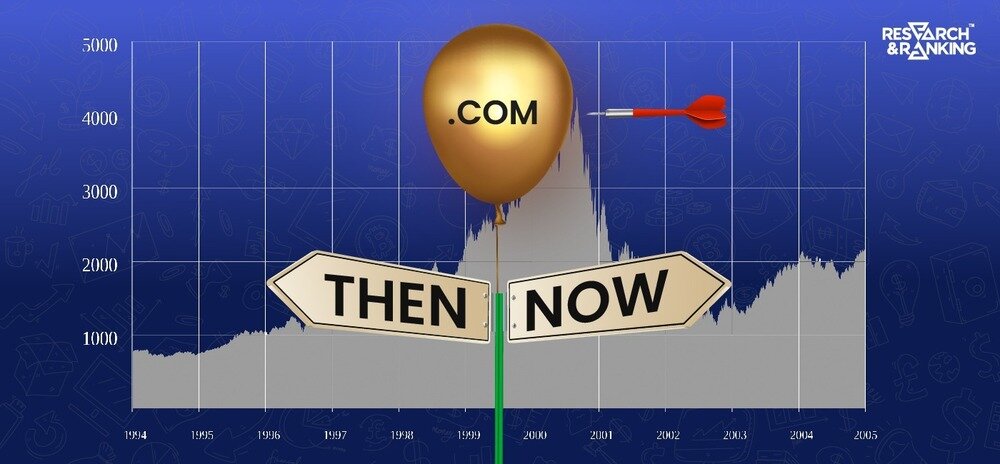Investors riding the wave of the current stock market boom may find themselves in a déjà vu moment, with uncanny resemblances to the dot-com era. Despite the excitement, cautionary signs are emerging, and JPMorgan analysts draw parallels that should give us pause.
Let’s delve into five key indicators that signal today’s stock market may not be as distinct from the past as we think.
1. Stock Market Composition: Déjà Vu of Tech Dominance
In the dot-com era, technology stocks held a dominating position in the market. Today, the top 10 stocks by market capitalization display a worrying lack of diversity, with only four sectors represented. Apple and Microsoft constitute a staggering 40% of these elite stocks, raising concerns about concentration and potential vulnerabilities.
2. Factor Exposure: Similarities Amidst Differences
JPMorgan’s analysis reveals eerie similarities in factor profiles between the early 2000s and today. High quality, rising momentum, and negative value characterize both periods. However, the current landscape is marked by less favorable growth exposure, signaling increased risk susceptibility. The present top 10’s factor profile resembles “Quality at a not so reasonable price.”
Know more about
IPO | Current IPO | Upcoming IPO | Listed IPO
3. Price Performance: Signs of an Imminent Shift
The remarkable outperformance of the stock market’s largest stocks in 2023 could be a prelude to a shift. Historically, after such surges, a reversion to the mean occurs. With the top seven S&P 500 firms responsible for over 60% of last year’s gains, JPMorgan warns of potential market drawdowns, especially within the top 10, signaling a need for vigilance.
4. Valuations: Stretching the Limits
While today’s top 10 price-earnings levels might not match the dot-com peak, the valuation premium is concerning. At 26.8x, it exceeds the broader market, echoing extremes seen in the 2000s. JPMorgan suggests that stretched valuations signal a concentration reaching its limits, emphasizing a need for careful evaluation in the current market.
5. Earnings-per-Share: A Growth Stalemate
Comparing the earnings-per-share (EPS) trajectory of today’s top 10 stocks to the dot-com peak reveals a concerning trend. Despite rising stock prices, EPS gains have been modest in recent years. This challenges the notion of a long-term growth advantage for today’s elite stocks, unlike the robust earnings developments seen in the dot-com era.
In scrutinizing today’s record-setting stock market, it’s essential to acknowledge the echoes of the dot-com era. While JPMorgan hesitates to label the current situation as a bubble, the warning signs are unmistakable. Analysts believe investors should exercise caution, study the market, diversify portfolios, and remain vigilant in the face of potential market shifts.
Read More: Grey Market Premium
*Disclaimer Note: The securities quoted, if any, are for illustration only and are not recommendatory. This article is for education purposes only and shall not be considered as recommendation or investment advice by Research & Ranking. We will not be liable for any losses that may occur. Investment in securities market are subject to market risks. Read all the related documents carefully before investing. Registration granted by SEBI, membership of BASL, and certification from NISM in no way guarantee the performance of the intermediary or provide any assurance of returns to investors.
FAQs
Should investors be concerned about a stock market crash like the dot-com era?
While JPMorgan draws parallels, predicting market crashes is complex. Investors should stay informed, diversify portfolios, and monitor market conditions.
How can one diversify a stock portfolio in the current market?
Diversification involves spreading investments across different assets. Consider a mix of stocks, bonds, and other instruments to mitigate risks.
What steps can investors take to navigate uncertainties in the stock market?
Stay informed, conduct thorough research, and consider consulting financial experts for personalized advice to navigate uncertainties effectively.
Are there sectors more resilient to potential market downturns?
Defensive sectors like utilities and consumer staples have historically shown resilience during market downturns. However, performance before does not indicate the potential for future results.
How can one assess the growth potential of a stock beyond traditional metrics?
Beyond traditional metrics, consider factors like industry trends, competitive advantages, and the company's long-term strategy to assess its growth potential.
How useful was this post?
Click on a star to rate it!
Average rating 4 / 5. Vote count: 1
No votes so far! Be the first to rate this post.
I’m Archana R. Chettiar, an experienced content creator with
an affinity for writing on personal finance and other financial content. I
love to write on equity investing, retirement, managing money, and more.
-
Archana Chettiarhttps://www.equentis.com/blog/author/archana/
-
Archana Chettiarhttps://www.equentis.com/blog/author/archana/
-
Archana Chettiarhttps://www.equentis.com/blog/author/archana/
-
Archana Chettiarhttps://www.equentis.com/blog/author/archana/

